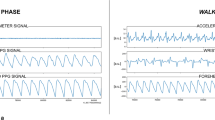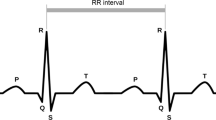Abstract
Wearable physiological sensors offer possibilities for the development of continuous stress detection models. Such models need to address the inter-individual and intra-individual differences in stress physiology. In this paper we propose and evaluate a normalization factor, \(Stress\,Response\,Factor~(SRF)\), to address such differences. SRF is computed using physiological features and the corresponding stress level at a reference point. The proposed normalization factor is evaluated in a dataset obtained from a free-living study with 10 participants, where each participant was monitored for 5 days during their working hours using different physiological sensors. We obtain an average reduction of mean squared error by up to 32% in models with SRF compared to the models without SRF.
Access this chapter
Tax calculation will be finalised at checkout
Purchases are for personal use only
Similar content being viewed by others
References
Alamudun, F., Choi, J., Gutierrez-Osuna, R., Khan, H., Ahmed, B.: Removal of subject-dependent and activity-dependent variation in physiological measures of stress. In: Proceedings of the 6th International Conference on Pervasive Computing Technologies for Healthcare (2012)
Altini, M., Penders, J., Amft, O.: Energy expenditure estimation using wearable sensors: a new methodology for activity-specific models. In: Proceedings of the conference on Wireless Health (2012)
Association, A.P.: Stress in America: paying with our health. Technical report, American Psychological Association (2014). http://www.apa.org/news/press/releases/stress/2014/stress-report.pdf
Bennet, J., Lanning, S.: The Netflix prize. In: KDD Cup and Workshop (2007)
Brantley, P.J., Waggoner, C.D., Jones, G.N., Rappaport, N.B.: A daily stress inventory: development, reliability, and validity. J. Behav. Med. 10, 61–73 (1987)
Breiman, L.: Random forests. Mach. Learn. 45, 5–32 (2001)
Brown, L., Grundlehner, B., van de Molengraft, J., Penders, J., Gyselinckx, B.: Body area network for monitoring autonomic nervous system responses. In: Pervasive Computing Technologies for Healthcare (2009)
Choi, J., Ricardo, G.O.: Using heart rate monitors to detect mental stress. In: Sixth International Workshop on Wearable and Implantable Body Sensor Networks (2009)
Drucker, H., Bruges, C.J.C., Kaufman, L., Smola, A.J., Vapnik, V.N.: Support vector regression machines. In: Advances in Neural Information Processing Systems (1996)
Eurofound, E.-O.: Psychological risks in Europe: prevalance and strategies for prevention. Technical report, Publications Office of the European Union, Luxemborg (2014)
Giakoumis, D., Tzovaras, D., Hassapis, G.: Subject-dependent biosignal features for increased accuracy in psychological stress detection. Int. J. Hum Comput Stud. 71, 425–439 (2013)
Healey, J., Picard, R.W.: Detecting stress during real-world driving tasks using physiological sensors. IEEE Trans. Intell. Transp. Syst. 6, 156–166 (2005)
Hjortskov, N., Rissen, D., Blangsted, A.K., Fallentin, N., Lundberg, U., Søgaard, K.: The effect of mental stress on heart rate variability and blood pressure during computer work. Eur. J. Appl. Physiol. 92, 84–89 (2004)
Jiapu, P., Tompkins, J.W.: A real-time QRS detection algorithm. IEEE Trans. Biomed. Eng. 32, 230–236 (1985)
Keytel, L., Goedecke, J., Noakes, T., Hiloskorpi, H., Laukkanen, R., van der Merwe, L., Lambert, E.: Prediction of energy expenditure from heart rate monitoring during submaximal exercise. J. Sports Sci. 23, 289–297 (2005)
Nadeau, D., Sabourin, C., Koninck, J.D., Matwin, S., Turney, P.D.: Automatic dream sentiment analysis. In: Proceedings of the Workshop on Computational Aesthetics at the 21st National Conference on Artificial Intelligence (AAAI) (2006)
Picard, R.W., Vyzas, E., Healey, J.: Toward machine emotional intelligence: analysis of affective physiological state. IEEE Trans. Pattern Anal. Mach. Intell. 23, 1175–1191 (2001)
Sano, A., Picard, R.W.: Stress recognition using wearable sensors and mobile phones. In: Humaine Association Conference on Affective Computing and Intelligent Interaction (2013)
Shi, Y., Ngyuen, M., Blitz, P., French, B., Frisk, S., Torre, F., Smailagic, A., Siewiorek, D., al’Absi, M., Kamarck, T., Kumar, S.: Personalized stress detection from physiological measurements. In: Proceedings of the 2nd International Symposium on Quality of Life Technology (2010)
Sun, F.-T., Kuo, C., Cheng, H.-T., Buthpitiya, S., Collins, P., Griss, M.: Activity-aware mental stress detection using physiological sensors. In: Gris, M., Yang, G. (eds.) MobiCASE 2010. LNICST, vol. 76, pp. 211–230. Springer, Heidelberg (2012). doi:10.1007/978-3-642-29336-8_12
Tanev, G., Saadi, D., Hoppe, K., Sorensen, H.: Classification of acute stress using linear and non-linear heart rate variability analysis derived from sternal ECG. In: 36th Annual International Conference of the Engineering in Medicine and Biology Society (EMBC) (2014)
Tibshirani, R.: Regression shrinkage and selection via the Lasso. J. Roy. Stat. Soc. B 58(1), 267–288 (1996)
Tulppo, M., Makikallio, T., Takala, T., Seppanen, T., Huikuri, H.V.: Quantitative beat-to-beat analysis of heart rate dynamics during exercise. Am. J. Physiol. Cell Physiol. 271, H244–H252 (1996)
Wijsman, J., Grundlehner, B., Penders, J., Hermens, H.: Trapezius muscle EMG as predictor of mental stress. ACM Trans. Embed. Comput. Syst. 12, 99:1–99:20 (2013)
Wijsman, J.: Sensing stress: stress detection from physiological variables in controlled and uncontrolled conditions. Ph.D. thesis, University of Twente (2014)
Wu, M., Cao, H., Nguyen, H.L., Surmacz, K., Hargrove, C.: Modeling perceived stress via HRV and accelerometer sensor streams. In: 37th Annual International Conference of the IEEE Engineering in Medicine and Biology Society (2015)
Xu, Q., Nwe, T.L., Guan, C.: Cluster-based analysis for personalized stress evaluation using physiological signals. IEEE J. Biomed. Health Inform. 19, 275–281 (2014)
Zhai, J., Barreto, A.: Stress detection in computer users through non-invasive monitoring of physiological signals. Biomed. Sci. Instrum. 42, 495–500 (2006)
Author information
Authors and Affiliations
Corresponding author
Editor information
Editors and Affiliations
Rights and permissions
Copyright information
© 2017 ICST Institute for Computer Sciences, Social Informatics and Telecommunications Engineering
About this paper
Cite this paper
Lamichhane, B., Großekathöfer, U., Schiavone, G., Casale, P. (2017). Towards Stress Detection in Real-Life Scenarios Using Wearable Sensors: Normalization Factor to Reduce Variability in Stress Physiology. In: Giokas, K., Bokor, L., Hopfgartner, F. (eds) eHealth 360°. Lecture Notes of the Institute for Computer Sciences, Social Informatics and Telecommunications Engineering, vol 181. Springer, Cham. https://doi.org/10.1007/978-3-319-49655-9_34
Download citation
DOI: https://doi.org/10.1007/978-3-319-49655-9_34
Published:
Publisher Name: Springer, Cham
Print ISBN: 978-3-319-49654-2
Online ISBN: 978-3-319-49655-9
eBook Packages: Computer ScienceComputer Science (R0)




